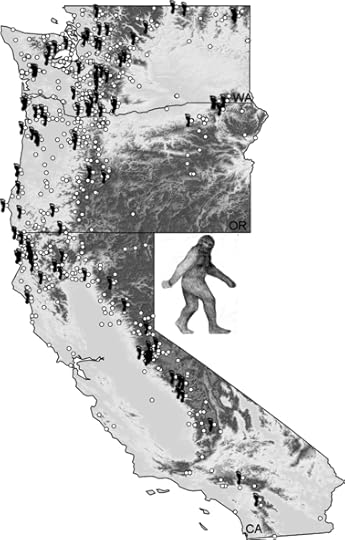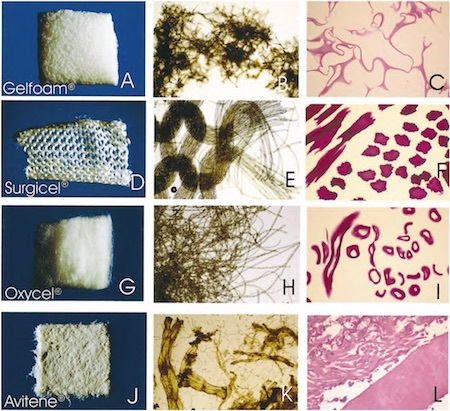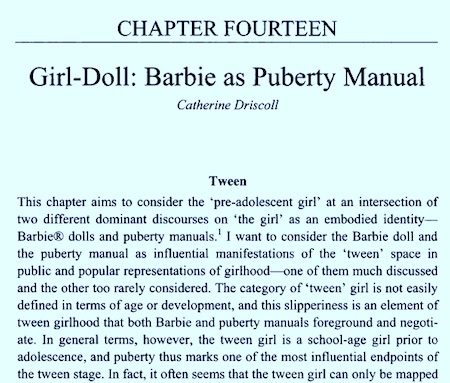Marc Abrahams's Blog, page 226
March 9, 2017
Textilomas, Gossypibomas, Gauzomas, or Muslinomas are Not Tumors
Woven fabrics occasionally turn up inside human bodies, where they can be mistaken for tumors. This study looks for and at some of them, and gives them colorful names:
“Textiloma (Gossypiboma) Mimicking Recurrent Intracranial Tumor,” Teresa Ribalta, Ian E. McCutcheon, Antonio G. Neto, Deepali Gupta, A. J. Kumar, David A. Biddle, Lauren A. Langford, Janet M. Bruner, Norman E. Leeds, and Gregory N. Fuller, Archives of Pathology and Laboratory Medicine, vol. 128, no. 7, 2004, pp. 749-758. The authors, at Universitat de Barcelona, Barcelona, Spain and The University of Texas at Houston Medical School, report:
Resorbable substances used to achieve hemostasis during neurosurgical procedures [gelatin sponges, various forms of cotton and rayon-based hemostats (cottonoids and kites), etc] have been reported to cause symptomatic mass lesions, most commonly following intra-abdominal surgery…. Hemostat-associated mass lesions have been variously referred to as textilomas, gossypibomas, gauzomas, or muslinomas….
Cases in which a textiloma constituted the sole finding on repeat surgery for recurrent brain tumor, or was a clinically significant component of a radiologically identified mass lesion together with residual tumor, constituted the study set.
Results.—Five textilomas were identified and evaluated.
Here’s further detail from the study:
(Thanks to Ivan Oransky for bringing this to our attention.)

Speaking whilst breathing-in (not restricted to ventriloquists)
Humans mostly tend to ‘breathe out’ whilst speaking (or making other vocalisations). Mostly but not exclusively. So-called Ingressive Speech is quite prevalent worldwide – and not just amongst ventriloquists. Take for example, a Scottish male saying “Aye aye I ken” (“Yes, yes I know”).
[.wav audio file here]
http://www.ida.liu.se/~robek28/audio/ingressive-Eklund_JIPA_2008_Fig_7b_ingr-aye_egr-aye-i-ken_male.wav
Robert Eklund, who is Associate Professor (Docent) in Computational Linguistics at Linköping University, Sweden, provides an online resource page devoted to Ingressive Phonation & Speech – including human vocalisations like the one above, and also cheetah-purring etc etc.
For an example paper, see: Pulmonic ingressive speech: a neglected universal? in Proceedings of Fonetik 2007, 30 May – 1 June 2007, Stockholm, Sweden. TMH-QPSR, vol. 50, pp. 21–24.

March 7, 2017
Tips for Mouse-Massage Parlor Personnel
An international team of mouse-massaging immunopharmacology researchers shares some of its secrets for massaging mice with a paintbrush or with gloved human hands, in this study:
“Massage-like stroking boosts the immune system in mice,” Benjamin Major, Lorenza Rattazzi, Samuel Brod, Ivan Pilipović, Gordana Leposavić, and Fulvio D’Acquisto, Scientific Reports, vol. 5, 2015. The authors, at Queen Mary University of London, UK, the Institute of Virology, Vaccines and Sera ‘Torlak’, Belgrade, Serbia, and the University of Belgrade, Serbia, explain some of their massage technique:
 “Brush and hand stroked mice were stroked at a pressure of 100-150 mmH2O (or 7-11 mmHg) and at a speed of about 3 cm/sec according to a previously described protocol, whereas control mice were not touched (by hand or brush) throughout the 60-minute treatment. Brush stroking was applied using a No.5 da Vinci paintbrush while hand stroking was applied using three fingers of the preferred hand of the investigator as previously described. For the hand-stroked treatment, the experimenter wore Bizzybee disposable vinyl gloves (Amazon, UK). These odourless gloves reduced human smell but maintained human contact i.e. warmth and pressure. Mice were stroked on the hairy skin found on the posterior dorsal thoracic and proximal hind limb in a cephalocaudal fashion (head to tail).”
“Brush and hand stroked mice were stroked at a pressure of 100-150 mmH2O (or 7-11 mmHg) and at a speed of about 3 cm/sec according to a previously described protocol, whereas control mice were not touched (by hand or brush) throughout the 60-minute treatment. Brush stroking was applied using a No.5 da Vinci paintbrush while hand stroking was applied using three fingers of the preferred hand of the investigator as previously described. For the hand-stroked treatment, the experimenter wore Bizzybee disposable vinyl gloves (Amazon, UK). These odourless gloves reduced human smell but maintained human contact i.e. warmth and pressure. Mice were stroked on the hairy skin found on the posterior dorsal thoracic and proximal hind limb in a cephalocaudal fashion (head to tail).”
Here’s further detail from the paper:

(Thanks to Bart Knols for bringing this to our attention.)

March 6, 2017
It’s complicated, dude (sociolinguistic investigations)
Scott F. Kiesling, who is a Sociolinguistic Professor at the Cathedral of Learning, Department of Linguistics, University of Pittsburgh, reminds us, via his blog, that complexity abounds.
“
I find myself saying (usually to myself), several times a day: “It’s not that simple!”
One of things that really gets to me about the world is the idea that there is a simple cause for big, complex problems. Journalists really like to do this, and of course politicians, but then again so do researchers in lots of fields including mine.”
One of the complex issues that the professor has investigated is ‘indirectness’ in language – going as far as to organize a special issue of the Journal of Pragmatics. Featuring essays on ‘Abduction and identity in family interaction: Ventriloquizing as indirectness’ and ‘Semantic and interactional indirectness in Tongan lexical honorification’.
Also don’t miss the professor’s paper ‘DUDE’ in American Speech 2004 Volume 79, Number 3: 281-305. (full version here) which Improbable first highlighted (highlit) here in 2006.

March 5, 2017
Anatomy pedagogy: Skipper, the armed doll that grows breasts
A doll called Skipper, designed to be a “sister” to the more famous Barbie doll, was a moving anatomy lesson to some of the children and adults who played with it. The doll’s most salient feature: when you lift Skipper’s arm, Skipper grows taller, and grows breasts. This video shows that process:
Skipper gets a scholarly analysis — as does her less developmentally-gifted sister — in the study “CHAPTER FOURTEEN: Girl-Doll: Barbie as Puberty Manual,” Catherine Driscoll, Counterpoints, vol. 245, Seven Going on Seventeen: Tween Studies in the Culture of Girlhood (2005), pp. 224-241. Here’s the beginning of that treatise:
Catherine Driscoll is Professor of Gender and Cultural Studies at the University of Sydney, Australia.

March 4, 2017
Know what? Professor Hopp Tells How-to-Think
All of human knowledge is summed up, possibly, in the opening words from this study:
“How to Think about Nonconceptual Content,” Walter Hopp, New Yearbook for Phenomenology and Phenomenological Philosophy, vol. 10, 2010, pp. 1-24. Professor Hopp explains:
“The current debate over nonconceptual content is of fundamental importance for both phenomenology and the theory of knowledge. It is, more over, an area in which phenomenologists working within a broadly Husserlian tradition can and have made important contributions. Despite this, the debate as a whole remains something of a mess.”
Professor Hopp is the Associate Dean for Learning Design, and the Herrick Professor of Business, and a Professor of Technology and Operations, and a Professor of Industrial and Operations Engineering at the University of Michigan’s Ross School of Business.

March 2, 2017
Anything goes with Ecological Niche Modelling? Even Sasquatch?
Authors J. D. Lozier, P. Aniello and M. J. Hickerson remind us, in a 2009 editorial for the Journal of Biogeography that :
“[…] very sensible-looking, well-performing (based on AUC and threshold tests) ENMs [Ecological Niche Models] can be constructed from questionable observation data.“
They demonstrate by building an Ecological Niche Model to predict the distribution of Sasquatch (Bigfoot) in western North America.
“[…] we use a large database of georeferenced putative sightings and footprints for Sasquatch in western North America, demonstrating how convincing environmentally predicted distributions of a taxon’s potential range can be generated from questionable site-occurrence data.”
See: ‘Predicting the distribution of Sasquatch in western North America: anything goes with ecological niche modelling’ in the Journal of Biogeography, Volume 36, Issue 9, September 2009, pp. 1623–1627

March 1, 2017
The Cultural Meaning of ‘Everybody, Let’s Tighten the Anus’
What depths has the anus song? This study takes a look:
 ” ‘Everybody, Let’s Tighten the Anus’: Exploring the Social and Cultural Meaning of a Korean Folksong,” Joonseong Lee [pictured here], Journal of Media and Religion, vol. 11, no. 4, 2012, pp. 216-230. The author, at California State University San Marcos, explains:
” ‘Everybody, Let’s Tighten the Anus’: Exploring the Social and Cultural Meaning of a Korean Folksong,” Joonseong Lee [pictured here], Journal of Media and Religion, vol. 11, no. 4, 2012, pp. 216-230. The author, at California State University San Marcos, explains:
“The immanent approach to the anus song with the view of Eastern qi philosophy provides this research with a cogent theoretical framework for energy spirituality, which is constructed in the practice of breathing, including anus breathing or anal sphincter exercise.”
Here is a performance of the song:
BONUS (possibly related): Song on the anus.

February 28, 2017
“Learning to love the secret language of urine”
Dr. Jonathan Reisman writes, in the Washington Post, about his professional love affair with a body fluid:
Many physicians are actively drawn to a particular bodily fluid, intrigued by its unique diagnostic mysteries. Each fluid that runs through the body is a language in which diseases speak to physicians, telling them what is wrong with a patient. And specializing means becoming fluent in one specific fluid’s dialect, learning to interpret its colors, textures and consistencies, and spending a career pondering its secrets.
As a medical student, I saw that a bodily fluid could shape a career. And though I resisted settling on just one (I remain a generalist), I have always been partial to pee….

February 27, 2017
How much water does it take to make a (250ml) cup of tea?
 The answer may depend on many factors – not least, on whom you ask. Dr John Kazer for example, who is a Carbon Footprint Certification Manager for the UK-based Carbon Trust will tell you that for a 250ml cup, it’ll take around 30 litres – but that’s just for the tea itself – considerably more if you add milk and sugar :
The answer may depend on many factors – not least, on whom you ask. Dr John Kazer for example, who is a Carbon Footprint Certification Manager for the UK-based Carbon Trust will tell you that for a 250ml cup, it’ll take around 30 litres – but that’s just for the tea itself – considerably more if you add milk and sugar :
“Somewhere around 30 litres of water is required for tea itself, 10 litres for a small dash of milk and a further 6 litres for each teaspoon of sugar. This means that a simple cup of tea with milk and two sugars could actually require 52 litres of water – enough to fill my kettle more than 30 times.”
See: How much water does it take to make a cup of tea?
More info, see: The water footprint of food from Professor Arjen Y. Hoekstra, Twente Water Centre, University of Twente, the Netherlands.
Also see: Is it a Mug or Cup? Recent Progress in Fuzziness Studies

Marc Abrahams's Blog
- Marc Abrahams's profile
- 14 followers






